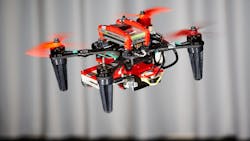Searching from Above for Solutions
The evolution of drones from technological curiosity to backyard toy to weaponized spy tool now has inspired a more basic research question: What can we really do with them?
Researchers are being asked to consider that question by the National Institute of Standards and Technology (NIST). They have launched a contest to find how to effectively use drones in search and rescue missions while considering various challenges such deployment might face. Among the barriers researchers will have to overcome to collect on the more than $700,00 in prizes: using optical sensing for image detection, overcoming spotty cellular coverage while continuing to deliver data and overcoming potential cybersecurity threats.
“Our goal at NIST is to accelerate the development and adoption of advanced wireless communications for the public safety community,” says Dereck Orr, PSCR division chief, in an article on Machine Design’s home page. “These competitions help us find problem solvers from around the world to help with this important research.” The program is being managed by researchers from Kansas State University and Mississippi State University.
To learn about eligibility requirements, visit challenge.gov. For additional information and to register, visit uastriplechallenge.com.
Droning on
Of course, one of a drone’s most useful functions is to hover over a given spot to provide a bird’s-eye view of hazardous or inaccessible locations. The typical four-rotor version of a drone provides good stability in such situations. But what happens when one of the rotor fails?
As a recent Machine Design article reports, researchers at the University of Zurich and the Delft University of Technology likened the result to a spinning ballerina—with the primary difference being that the drone eventually loses stability and crashes.
Researchers added an emergency control strategy that uses information from onboard cameras to stabilize the drone. Moreover, they said, the solution can keep the drone flying autonomously after one rotor suddenly gives out. By attaching event cameras as well as standard cameras to the drones, they developed an algorithm that managed the difference between what the camera was seeing and where it was flying, and the onboard computer system kept the drone level in flight.
The technology also works in low light or where GPS signals are weak or absent. Here’s a look at the drone technology in action.
About the Author

Bob Vavra
Editor Emeritus, Machine Design and Power & Motion
Bob Vavra is the former senior content director of Machine Design and Power & Motion.
